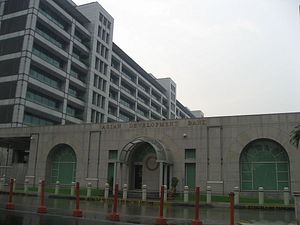The 50th annual Asian Development Bank (ADB) meeting was held in Yokohama from Thursday to Sunday, amid unprecedented challenges to the Japan- and U.S.-led infrastructure bank. Japan’s concerns about China’s increasing assertiveness in the realm of Asian development financing have been obvious since the creation of the Asian Infrastructure Investment Bank (AIIB) in October 2014. However, Japan now faces an unexpected challenge from its own partner: the potential retreat of U.S. leadership.
At a recent event in Washington, AIIB President Jin Liqun made the eloquent case for AIIB’s transparent nature and multilateral design – trying to assuage Japanese and American concerns about the ADB being overshadowed or outflanked by the AIIB’s looser requirements. However, skepticism in Washington and Tokyo will remain high until projects begin being implemented according to the principles that Jin preached.
And regardless of AIIB’s intentions, there is no denying that – for better or for worse – the arrival of a new kid on the block means that the ADB will have to work harder to please their clientele. Developing countries have a better negotiating position, a backup option so to speak, if they do not like the terms that the ADB demands. Countries like Vietnam and Bangladesh can benefit from “positive competition” between the two lenders.
This “positive competition” has sharpened ADB’s focus on distinguishing itself from AIIB by emphasizing quality and supporting non-infrastructure projects.
On Saturday, Finance Minister Taro Aso pledged Japan will provide $40 million over two years to a new ADB fund set up to promote high-quality infrastructure development in the region. The emphasis is on “enhancing quality of infrastructure in terms of lifecycle cost and environmental and social considerations… From this perspective, I welcome the bank’s recent decision to introduce new procurement procedures that put more emphasis on quality,” Aso said.
Furthermore, while the emphasis will continue to be on infrastructure, unlike the AIIB, the ADB also finances poverty reduction, healthcare, and education initiatives.
Interestingly, Aso also pledged that Japan would redouble efforts to create a “Southeast Asia Disaster Risk Insurance” to ease financing to deal with natural disasters. Pointing to concerns about climate change, Aso wants the ADB to be better prepared to assist in post-disaster reconstruction and building disaster-resilient societies.
But acknowledging the reality of Asia’s massive financing needs – with as much as $26 trillion expected to be spent on infrastructure over the next 15 years – Tokyo is beginning to moderate its language. ADB President Takehiko Nakao stated at the Yokohama meeting’s opening new conference: “We don’t need to regard the AIIB as a kind of rival, because there is a very large need to finance, so we can cooperate.” The ADB and AIIB have co-financed a highway project in Pakistan, a natural gas field upgrade in Bangladesh, and a bypass road in Georgia since 2015.
But as stated earlier, these concerns have been long-standing, meaning Japan has had time to think about how to adjust its position to highlight the ADB’s merits.
The retreat of U.S. leadership from the ADB is the newer challenge. Nakao told reporters at a news conference wrapping up the meeting that it “isn’t really good” that the second largest shareholder is lacking a permanent ambassador to the ADB.
Currently, Eli H. Miller, chief of staff at the Treasury Department, is acting director of both the ADB and the European Bank for Reconstruction and Development (EBRD). Miller did not attend the ADB meeting; the top U.S. representative was Robert Kaproth, U.S. deputy assistant secretary for Asia. The U.S. ambassador to the ADB was recalled at the beginning of the Trump administration, and a permanent ambassador role – along with many other key positions – remains vacant. It is unclear what an “America First” policy means for the United States’ role in the ADB.
Nakao expressed hopes that the United States will step up and support the ADB. He said, “The U.S. investment in Asia has been very efficient and productive. I hope the U.S. government will look at these issues and continue to invest in the ADB.”
Given Trump’s track record on Asia policy thus far, it is highly doubtful that he has any coherent strategy regarding Washington’s role in the ADB, or the U.S. position toward the AIIB for that matter. In this regard, Japan will be left out to dry for a little while longer – at least until key posts can be filled in the administration to advocate for U.S. engagement, a bipartisan pillar of U.S. policy toward Asia until now. In the meantime, Japan will have to quickly learn to take leadership in Asia without the support and backing of the United States. Stuck between the new U.S. president’s isolationism and China’s expansionary ambitions, it is a lesson that must be learned with only a very small margin of error.

































